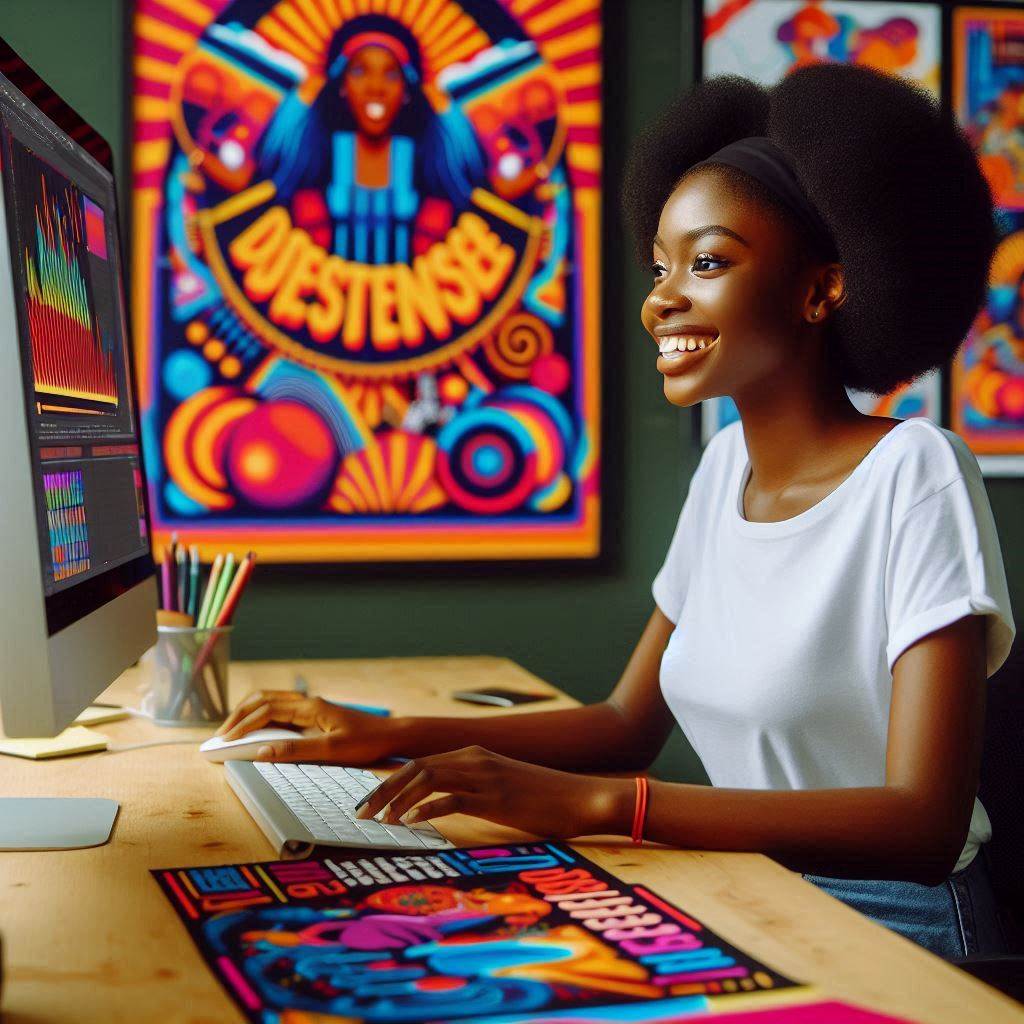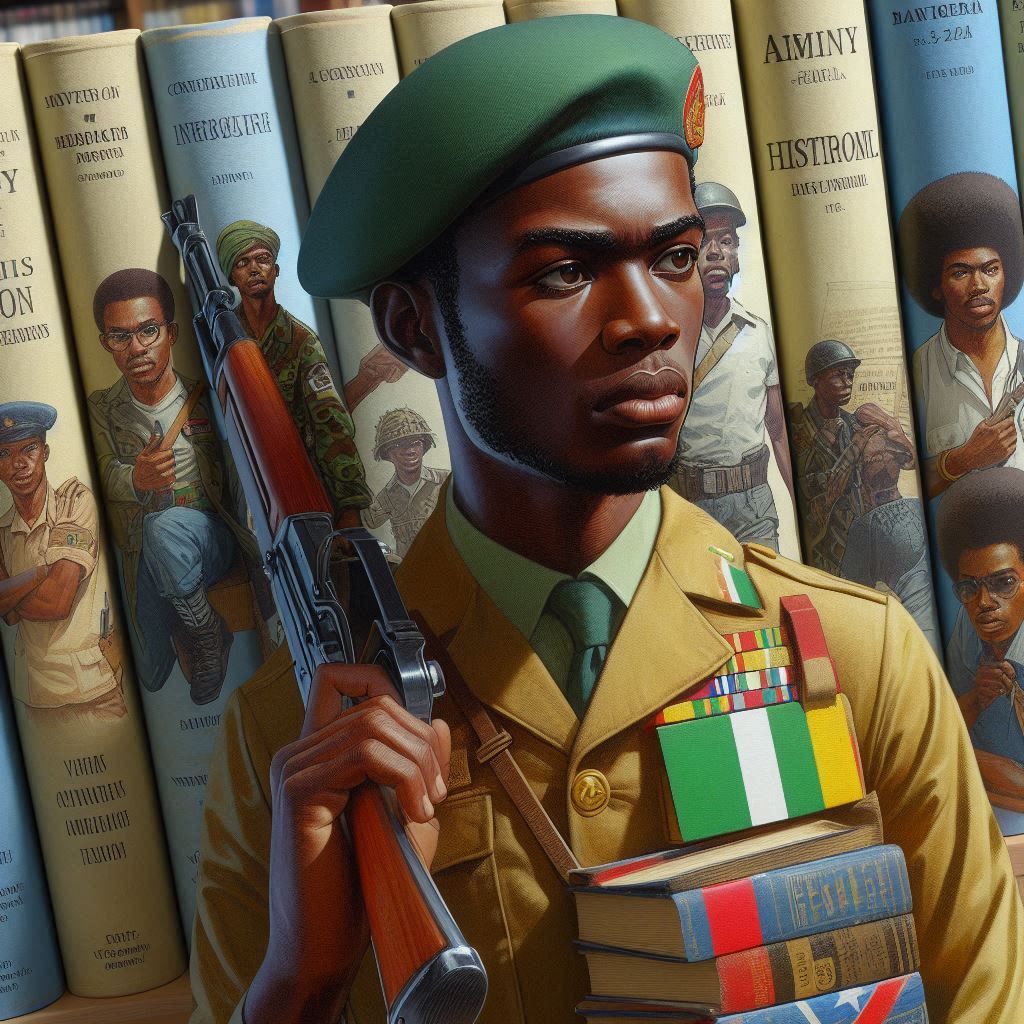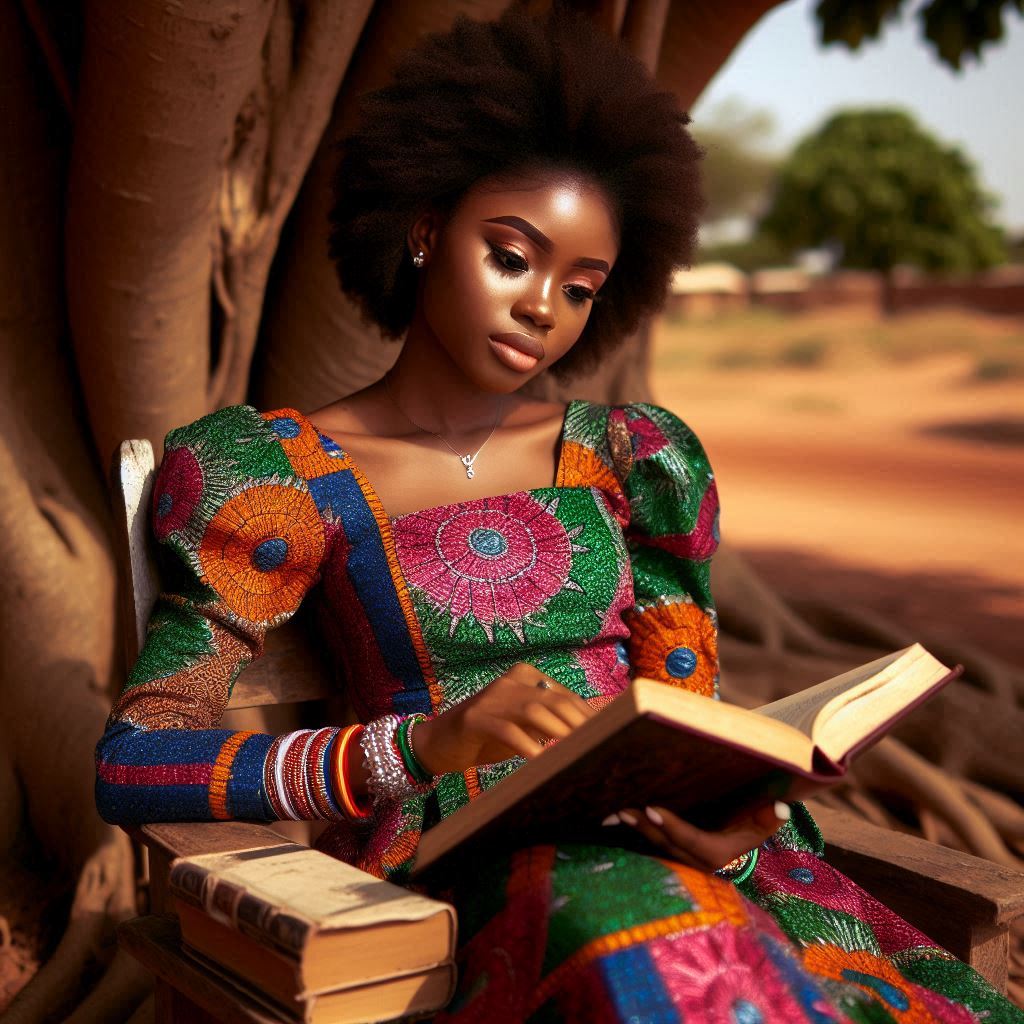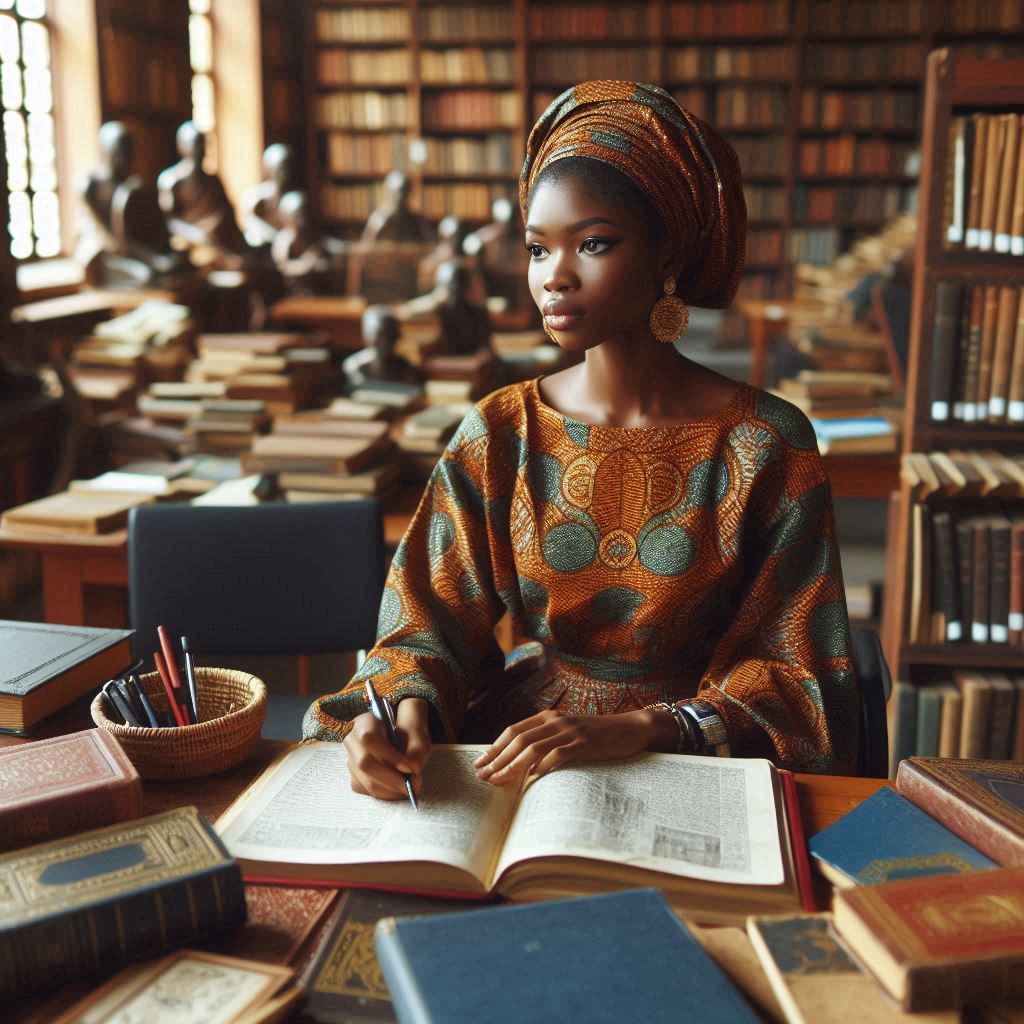Introduction
Art and technology are converging in Nigeria, creating new forms of artistic expression. This intersection is transforming the art landscape in significant ways. Nigerian artists are embracing technology, enhancing their creativity and expanding their reach.
Traditionally, Nigerian art has been deeply rooted in cultural and historical contexts. Artists used conventional materials like wood, bronze, and fabric.
However, the introduction of digital tools has changed this dynamic. Artists are now exploring new mediums and techniques.
The Influence of Digital Tools
Digital tools are reshaping the artistic process in Nigeria. Artists use software for design, animation, and 3D modeling.
These tools enable the creation of intricate and innovative works that were previously unimaginable. This technological shift is broadening the scope of Nigerian art.
Social Media and Art
Social media platforms have become crucial for Nigerian artists. They use these platforms to showcase their work and connect with a global audience.
Instagram, Facebook, and Twitter are popular choices. Artists can now reach potential buyers and collaborators worldwide. This connectivity fosters collaboration and inspiration across borders.
Virtual Reality and Augmented Reality
Virtual reality (VR) and augmented reality (AR) are revolutionizing the art experience in Nigeria. Artists are using VR to create immersive installations.
AR is being utilized to enhance traditional artworks with interactive elements. These technologies offer new ways for audiences to engage with art.
Blockchain and Art
Blockchain technology is making waves in the Nigerian art market. It offers a secure way to authenticate and sell digital art. Non-fungible tokens (NFTs) are gaining popularity.
Artists can now sell unique digital works and receive fair compensation. This innovation is ensuring the integrity and provenance of digital art.
Digital Art Exhibitions
Digital art exhibitions are becoming more common in Nigeria. Galleries and museums are adopting digital displays and virtual tours. This approach makes art accessible to a wider audience.
People can experience exhibitions from the comfort of their homes. These digital spaces are fostering a new appreciation for contemporary Nigerian art.
The Role of Technology in Art Education
Technology is also transforming art education in Nigeria. Online courses and tutorials are available to aspiring artists. They can learn new techniques and gain exposure to global art trends.
Educational platforms are bridging the gap between traditional and modern art practices.
Challenges and Opportunities
Despite the advancements, challenges remain. Limited access to technology and digital infrastructure can hinder progress. However, these challenges present opportunities for growth and development.
By addressing these issues, Nigeria can continue to lead in art and technology innovation.
Generally, The fusion of art and technology is propelling Nigerian art into a new era. Digital tools, social media, VR, AR, and blockchain are driving artistic innovations.
These advancements are expanding the possibilities for artists and audiences alike. As technology continues to evolve, so will the landscape of Nigerian art.
Historical Perspective: Art and Technology in Nigerian Art
Evolution of Art in Nigeria
Nigerian art has a rich and diverse history. Ancient art forms include Nok terracottas and Ife bronzes. These early artworks reveal sophisticated craftsmanship. Art in Nigeria has always reflected its vibrant culture. The influence of religion, politics, and social changes is evident in Nigerian art.
Colonialism introduced new art forms. Nigerian artists began incorporating Western techniques. This period saw a blend of traditional and contemporary styles. Artists like Ben Enwonwu gained international acclaim. His works embodied this fusion of influences.
Post-independence, Nigerian art experienced a renaissance. The Zaria Art Society emerged, promoting modernism. Artists like Uche Okeke and Bruce Onobrakpeya led this movement. They emphasized storytelling through contemporary methods.
Impact of Technology on Artistic Expression
Technology has significantly impacted Nigerian art. The introduction of photography changed visual storytelling. Early photographers documented Nigerian life and culture. This medium became a powerful tool for preserving history.
Digital art is the latest evolution. It allows for endless creativity and experimentation. Nigerian artists now use software to create intricate designs. Digital platforms offer global exposure and networking opportunities. Social media has made Nigerian art accessible worldwide.
Key Moments in History
The Arrival of Photography
Photography arrived in Nigeria in the late 19th century. It revolutionized how stories were told. J. A. Green was a pioneering Nigerian photographer. His work provided a visual record of colonial Nigeria.
Photography helped preserve cultural heritage and traditions.
The Nigerian Art Renaissance
The 1950s and 1960s were pivotal decades. The Zaria Art Society was founded during this time.
This group of artists embraced modernism. They incorporated traditional motifs with contemporary techniques. This era marked the birth of modern Nigerian art.
The Digital Revolution
The 21st century brought a digital revolution. Nigerian artists embraced new technologies. Digital tools expanded creative possibilities. Artists like Laolu Senbanjo gained fame through social media. His intricate designs showcase the power of digital art.
Shaping Nigerian Art Through Technology
Technology continues to shape Nigerian art. Artists use 3D printing for sculpture and installations. Virtual reality offers immersive art experiences. These innovations push the boundaries of creativity. They allow artists to explore new dimensions of expression.
The internet has democratized art. It provides a platform for emerging artists. Online galleries and social media connect artists with global audiences. Technology enables collaborations across borders. It fosters a global art community.
Basically, The evolution of Nigerian art is a testament to its resilience and adaptability. Technology has played a crucial role in this journey.
From photography to digital art, each technological advance has left its mark. Nigerian artists continue to innovate and inspire. Their work reflects the dynamic interplay between tradition and modernity.
The future of Nigerian art is bright, with technology paving the way for endless possibilities.
Read: Communication Arts: Balancing Theory and Practice
Use of digital tools
In recent years, Nigerian artists have increasingly incorporated digital tools into their creative processes. These artists are blending tradition with modernity, producing groundbreaking art that resonates globally.
The use of graphic design software, 3D printing, and digital photography is revolutionizing the Nigerian art scene.
Graphic Design Software
Nigerian artists are embracing graphic design software to create visually stunning works. Programs like Adobe Photoshop and Illustrator are essential tools.
These software applications enable artists to experiment with colors, textures, and forms. Digital illustrations and designs often reflect Nigeria’s rich cultural heritage.
Example: Osinachi
Osinachi is a digital artist who uses Microsoft Word to create unique digital artworks. His work explores contemporary African experiences.
Osinachi’s pieces are vibrant, incorporating traditional patterns and modern themes. His use of a common software in unconventional ways highlights his innovative spirit.
3D Printing
3D printing is another tool that Nigerian artists are leveraging. This technology allows for the creation of complex, three-dimensional objects. Artists can produce sculptures and installations with precise detail. 3D printing enables the realization of previously unimaginable concepts.
Example: Adeola Balogun
Adeola Balogun is a sculptor using 3D printing to expand his artistic boundaries. His works combine traditional sculpting methods with modern technology.
Balogun’s 3D-printed pieces often explore socio-political themes, making powerful statements through art. His integration of digital tools and traditional skills is exemplary.
Digital Photography
Digital photography has opened new avenues for Nigerian artists. High-resolution cameras and editing software like Adobe Lightroom enhance their photographic work.
Artists can manipulate images to create surreal, thought-provoking compositions. Digital photography allows for experimentation and innovation.
Example: Lakin Ogunbanwo
Lakin Ogunbanwo is a renowned Nigerian photographer known for his striking portraits. He uses digital tools to enhance his images, creating a unique visual style.
Ogunbanwo’s work often explores themes of identity, culture, and fashion. His digital photography pushes the boundaries of conventional portraiture.
Pushing Boundaries
Nigerian artists are not just adopting digital tools; they are pushing the boundaries of traditional art forms. By integrating technology, they create hybrid works that challenge viewers’ perceptions. This fusion of old and new fosters a dynamic, evolving art scene.
Example: Jelili Atiku
Performance artist Jelili Atiku incorporates digital media into his works. He uses video projections and digital soundscapes to enhance his performances.
Atiku’s use of technology creates immersive, multi-sensory experiences. His innovative approach is redefining performance art in Nigeria.
In summary, The use of digital tools in Nigerian art is driving innovation and creativity. Artists are blending traditional techniques with modern technology to produce groundbreaking works.
Graphic design software, 3D printing, and digital photography are key tools in this transformation. These advancements ensure that Nigerian art continues to evolve and inspire.
Read: How to Apply for Communication Arts Programs
Virtual Reality and Augmented Reality: Revolutionizing Nigerian Art
Immersive Art Experiences through Virtual Reality
Nigerian artists are embracing virtual reality (VR) to create compelling and immersive art experiences. VR allows artists to construct entire worlds, engaging viewers in a 360-degree visual and auditory experience.
This technology has opened up new possibilities for storytelling, allowing artists to craft narratives that envelop the audience. Lagos-based artist, Olalekan Jeyifous, uses VR to showcase futuristic cityscapes, reflecting on urbanization in Nigeria.
By donning a VR headset, viewers can explore his visionary environments, experiencing art in an unprecedented, interactive manner.
Augmented Reality: Enhancing Traditional Art
Augmented reality (AR) is another transformative tool for Nigerian artists. Unlike VR, AR superimposes digital elements onto the real world, enhancing physical artworks with additional layers of information or interactivity.
Nigerian painter, Laolu Senbanjo, incorporates AR into his work to add dynamic, animated elements to his already intricate designs. Visitors can use their smartphones to see his art come alive, adding a new dimension to their appreciation.
This fusion of traditional and digital art forms creates a more engaging and informative experience for the audience.
Impact on Audience Engagement
The integration of VR and AR in Nigerian art has significantly enhanced audience engagement. These technologies invite viewers to participate actively rather than passively observing.
For instance, VR art installations require viewers to move around and explore, creating a sense of adventure and discovery.
AR applications, on the other hand, encourage interaction through smartphones or tablets, making the viewing experience more personal and engaging.
This heightened level of engagement can foster a deeper emotional connection between the audience and the artwork.
Accessibility of Art in Nigeria
VR and AR technologies are also improving the accessibility of art in Nigeria. Traditional art exhibitions are often limited by physical space and geographical location.
VR can transcend these limitations, allowing art lovers to experience exhibitions from anywhere in the world. This is particularly beneficial in a country where many regions lack access to art galleries and museums.
AR also democratizes art by making it more accessible through mobile devices, which are widespread in Nigeria. People who might not visit a gallery can now experience art in their everyday environments.
Future Prospects and Challenges
The future of VR and AR in Nigerian art looks promising, with many artists eager to explore these technologies further. However, there are challenges to consider, such as the high cost of VR equipment and the need for technical expertise.
Despite these obstacles, the potential benefits of VR and AR in enhancing artistic expression and audience engagement are immense.
As these technologies become more affordable and widespread, their impact on Nigerian art will likely grow, paving the way for more innovative and inclusive art experiences.
In review, VR and AR are revolutionizing how Nigerian artists create and present their work.
By making art more immersive and accessible, these technologies are transforming the cultural landscape, promising a vibrant future for Nigerian art.
Read: Introduction to African and Asian Studies in Nigeria
Transform Your Career with Expert Guidance
Get personalized mentorship consulting that’s tailored to your unique path. Our expert advice is actionable and exclusive.
Get Started
Social Media and Online Platforms
The Role of Social Media in Promoting Nigerian Art
Social media has revolutionized the way Nigerian art reaches a global audience. Platforms like Instagram and Facebook have become essential tools for artists.
They provide a space where artists can showcase their work to millions of potential viewers worldwide. This digital visibility helps artists gain recognition and build their brand.
Through social media, Nigerian art is no longer confined to local galleries and exhibitions. It can now be appreciated by people across different continents.
This global exposure has led to increased interest and appreciation for Nigerian art. Collectors and art enthusiasts from around the world can now discover and purchase artworks online.
Social media also allows artists to engage directly with their audience. They can receive immediate feedback and build a loyal following.
This direct interaction fosters a deeper connection between artists and their fans. It also helps artists understand their audience’s preferences and interests better.
Leveraging Social Media to Showcase Work
Nigerian artists use social media to showcase their work creatively and effectively. They share high-quality images and videos of their artworks, highlighting intricate details and techniques.
This visual content is often accompanied by engaging captions that tell the story behind each piece. By doing so, artists create a narrative that resonates with their audience.
Many artists utilize Instagram’s features like Stories and Reels to provide behind-the-scenes glimpses into their creative process. These short, engaging videos attract more viewers and keep their audience engaged.
By regularly updating their social media profiles, artists maintain a consistent online presence.
Artists also participate in online art challenges and collaborations to increase their visibility. These events help them reach new audiences and gain more followers.
For instance, popular hashtags like #NigerianArt or #AfricanArt can significantly boost the reach of their posts.
Connecting with Other Artists
Social media platforms serve as a hub for networking and collaboration among Nigerian artists. Through these platforms, artists can connect with their peers, share ideas, and collaborate on projects.
This networking helps artists learn from each other and grow their skills.
Online platforms like LinkedIn and Twitter are also valuable for professional networking. Artists can connect with galleries, curators, and art critics, expanding their professional network.
This can lead to opportunities for exhibitions, commissions, and other art-related projects.
Furthermore, online art communities and forums provide a space for artists to seek advice and share their experiences. These communities offer support and encouragement, fostering a sense of camaraderie among artists.
In essence, Social media and online platforms play a crucial role in promoting Nigerian art to a global audience. They provide a space for artists to showcase their work, engage with their audience, and connect with other artists.
By leveraging these platforms, Nigerian artists can reach new heights and gain the recognition they deserve. The digital age has truly opened up a world of possibilities for Nigerian art.
Read: Famous Nigerian Alumni of Communication Arts Programs
Collaborations with Tech Companies
Innovative Art Projects Through Collaborations
Nigerian artists are increasingly partnering with tech companies to produce groundbreaking art. These collaborations fuse traditional creativity with cutting-edge technology.
One notable example is the partnership between artist Laolu Senbanjo and tech giant, Apple. Together, they created unique artwork for the Apple Watch, blending Yoruba symbols with modern tech.
Another exciting collaboration involves Nigerian artist Victor Ehikhamenor and Google. Ehikhamenor worked with Google Arts & Culture to digitize his art, making it accessible worldwide.
This partnership has allowed his intricate designs to reach a global audience, showcasing Nigerian art on an unprecedented scale.
Driving Technological Advancements
These collaborations are not just about creating art; they drive technological advancements in the Nigerian art scene. Tech companies provide artists with tools and platforms that were previously unavailable.
For instance, VR and AR technologies are transforming how art is created and experienced. Nigerian artist, Olalekan Jeyifous, has utilized VR to create immersive installations that captivate audiences.
Tech companies also offer artists access to advanced software and hardware. This access enables the creation of more sophisticated and intricate works.
For example, artists are now using AI to generate complex patterns and designs that would be impossible by hand.
Empowering Artists with Digital Tools
Tech collaborations empower Nigerian artists by equipping them with digital tools. These tools enhance their creativity and broaden their scope.
One example is the collaboration between artist Kelechi Amadi-Obi and Canon. Canon provided high-end cameras and editing software, allowing Amadi-Obi to explore new photographic techniques and styles.
Digital tools also help artists reach wider audiences through social media and online platforms. This exposure is crucial for gaining recognition and selling their work.
Collaborations with tech companies often include digital marketing support, which is invaluable for artists.
Creating New Art Forms
Partnerships between Nigerian artists and tech companies are giving rise to new art forms. These new forms blend traditional art with digital innovation.
For instance, Nigerian artist Chidinma Nnoli collaborated with a tech company to create digital sculptures. These sculptures can be viewed and interacted with online, providing a novel art experience.
Another innovative project is the collaboration between artist Ayodele Okeowo and Microsoft. They developed a series of interactive art pieces using AI and machine learning.
These pieces respond to viewer interactions, making the art experience dynamic and engaging.
Fostering a Tech-Savvy Art Community
These collaborations foster a tech-savvy art community in Nigeria. Artists are learning to integrate technology into their work, expanding their creative horizons.
Tech companies often conduct workshops and training sessions for artists. These initiatives help artists stay updated with the latest technological trends.
Furthermore, collaborations provide networking opportunities, connecting artists with industry leaders and potential patrons. This network is crucial for professional growth and career development.
As a result, the Nigerian art scene is becoming more vibrant and innovative.
In a nutshell, Collaborations between Nigerian artists and tech companies are revolutionizing the art landscape. These partnerships are driving technological advancements, empowering artists, and creating new art forms.
As technology continues to evolve, these collaborations will undoubtedly lead to even more innovative and exciting developments in Nigerian art.
Artistic Experiments with Technology
Embracing Artificial Intelligence in Art
Nigerian artists are integrating artificial intelligence (AI) to create groundbreaking art. AI offers new creative possibilities and transforms traditional methods.
Artists like Olawunmi Banjo use AI to generate unique visual patterns. These patterns blend with her painting techniques, creating captivating art pieces.
The fusion of AI and traditional art methods is reshaping the Nigerian art landscape. Artists program AI to mimic human creativity, producing astonishingly original works.
This technological integration challenges the definition of art and its creation.
Interactive Installations: Engaging the Audience
Interactive installations are becoming a staple in Nigerian art exhibitions. These installations invite audience participation, creating an immersive experience.
Laolu Senbanjo’s “Sacred Art of the Ori” employs interactive elements that respond to viewer movements. This interactive approach transforms passive viewing into active engagement.
Technology allows artists to craft dynamic, responsive environments. These environments change based on audience interactions, offering a unique experience to each viewer.
The inclusion of sensors and digital interfaces enhances these installations’ interactivity.
Robotics: A New Medium for Creativity
Robotics is an emerging field in Nigerian art. Artists are using robots to perform tasks traditionally done by humans. Victor Ehikhamenor’s robotic installations combine technology with cultural motifs.
These robots create intricate designs, blending art with engineering. Robotics introduces precision and complexity previously unattainable by hand.
Nigerian artists are exploring how robots can collaborate in the creative process. This exploration questions the boundaries between human creativity and machine efficiency.
Challenges in Technological Integration
Incorporating technology in art comes with significant challenges. High costs of advanced technology can be prohibitive for many artists.
Additionally, a lack of technical expertise can hinder creative experimentation. Nigerian artists often need to learn coding and engineering skills to use new technologies effectively.
This need for multidisciplinary knowledge can be daunting. Furthermore, technological art faces preservation challenges, as digital media can be impermanent.
Artists must find ways to ensure the longevity of their technologically-infused works.
Opportunities for Growth and Innovation
Despite these challenges, the opportunities for Nigerian artists are immense. Technology provides new tools for expression and innovation. Artists can reach global audiences through digital platforms.
Online exhibitions and virtual galleries offer new revenue streams. These platforms allow artists to showcase their work beyond geographic limitations.
Collaboration with technologists can lead to groundbreaking projects. Such collaborations blend artistic vision with technical expertise, pushing creative boundaries.
Furthermore, technology can democratize art creation, making it accessible to a broader audience.
Pushing Traditional Boundaries
Nigerian artists are at the forefront of merging tradition with innovation. By experimenting with technology, they push the boundaries of what art can be.
These experiments challenge conventional art practices and offer fresh perspectives. Artists are redefining their roles in society, becoming both creators and innovators.
The integration of technology in art is not just a trend; it represents a paradigm shift. This shift opens up new avenues for artistic expression and cultural dialogue.
In fact, Nigerian artists are pioneering the use of technology in art. Their work exemplifies the fusion of tradition and innovation.
By embracing AI, interactive installations, and robotics, they are redefining art in the modern era. Despite challenges, the opportunities for growth and creative expression are vast.
The future of Nigerian art lies in this dynamic intersection of art and technology.
Conclusion
Technology: A Catalyst for Innovation in Nigerian Art
Technology is revolutionizing Nigerian art, driving innovation and expanding creative boundaries. Digital tools and platforms are providing artists with new means of expression.
By integrating technology, artists are creating more dynamic, interactive, and engaging artworks. This transformation is evident in various forms of art, from digital painting to virtual reality installations.
Digital Tools and Techniques
Nigerian artists are embracing digital tools to enhance their creative processes. Software like Adobe Photoshop and CorelDRAW allows for detailed digital painting and design.
These tools enable artists to produce high-quality, intricate works that were previously unimaginable. Furthermore, digital sculpting with software like ZBrush is allowing for the creation of complex, three-dimensional artworks.
Social Media and Online Platforms
Social media platforms are providing Nigerian artists with unprecedented exposure. Platforms like Instagram and Facebook are serving as virtual galleries, allowing artists to showcase their work to a global audience.
Online marketplaces like Etsy and ArtStation are enabling artists to sell their works directly to buyers worldwide. This digital presence is crucial for reaching new audiences and establishing international careers.
Virtual Reality and Augmented Reality
Virtual reality (VR) and augmented reality (AR) are pushing the boundaries of traditional art forms. Nigerian artists are exploring VR to create immersive art experiences that engage viewers in entirely new ways.
AR is being used to add interactive elements to physical artworks, enhancing viewer engagement and interaction. These technologies are opening up new dimensions of artistic expression.
3D Printing and Digital Fabrication
3D printing is another technological advancement influencing Nigerian art. Artists are using 3D printers to create intricate sculptures and installations.
This technology allows for the precise and rapid production of complex designs, facilitating innovation in sculpture and mixed media art. Digital fabrication techniques are also enabling artists to experiment with new materials and forms.
The Importance of Embracing Technology
Embracing technology is essential for contemporary Nigerian artists. Technology not only enhances creative capabilities but also offers new ways to connect with audiences.
By integrating digital tools and platforms, artists can expand their reach and impact. The use of technology in art is not just a trend but a vital component of the modern artistic landscape.
Looking Ahead
The fusion of art and technology in Nigeria is still in its early stages, but its potential is vast. As artists continue to explore and integrate new technologies, we can expect to see even more innovative and boundary-pushing works.
Embracing technology will be crucial for Nigerian artists to stay relevant and thrive in the global art scene.
Final Thoughts
In closing, technology is driving significant innovation in Nigerian art. By embracing digital tools, social media, VR, AR, and 3D printing, Nigerian artists are expanding their creative horizons.
It is essential for artists to continue exploring these technologies to remain at the forefront of contemporary art. The future of Nigerian art is bright, with technology playing a pivotal role in its evolution.




